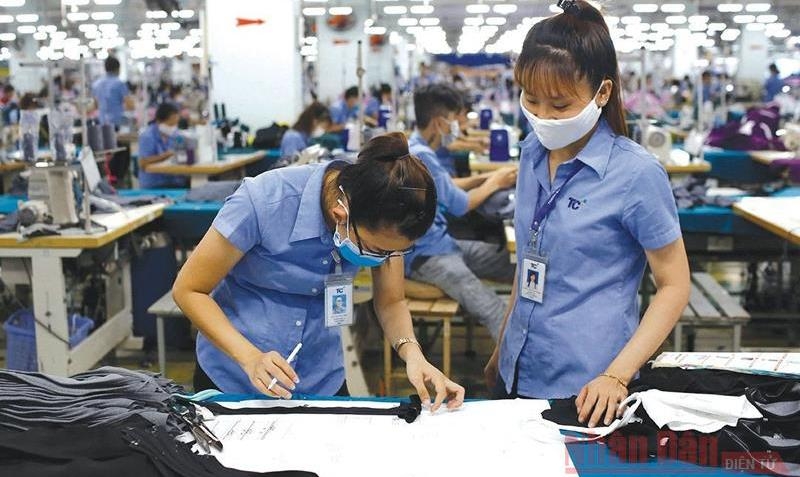Increasing orders
Hung Yen Garment Corporation has faced many difficulties due to the COVID-19 pandemic in 2020 withits revenue decreasing by about 5% compared to 2019. However, in early 2021, since the COVID-19 vaccination programme began, orders have gradually returned at the company.
Chairman of the Board of Directors of Hung Yen Garment Corporation Nguyen Xuan Duong said his company now has orders to fulfill until the end of July 2021, focusing on the US market (over 50%), Europe, and Japan.
“Hung Yen Garment Corporation is expected to grow by5-10% in 2021 to compensate for the deficit in 2020, a slight increase compared to 2019,” Nguyen Xuan Duong said.
Regarding the yarn sector, although the beginning of the year is not the usual time demand for textiles goes up, orders made for the first six months of 2021 at the DalatWorsted Spinning Company have been nearly equivalent to the last six months of 2020.
“2021 will certainly be a difficult year, but the company’s products are mainly exported to Europe, where the market is improving. In addition, the EU-Vietnam Free Trade Agreement (EVFTA) will certainly create impetus fortextile and garment exports to Europe,” said Alessandro Di Palma, CEO of Dalat Worsted Spinning Company.
The increase in orders has helped boost the export turnover of the textile and garment industry. Statistics from the Ministry of Industry and Trade show that total export turnover of textiles and garments reached US$5.954 billion in the first two months of 2021 while import turnover reached US$3.167 billion. Thus, the industry reported a trade surplus of US$3.299 billionwhile the added value of the industry has been quite high at 55.4%.
The initial recovery of the industry is thanks toenterprises’ efforts in seeking suitable directions after ayear of living with the pandemic. The rolling out of vaccines against the COVID-19 virus by countries across the world has also helped increase people’s confidence, contributing to stimulating consumer demand, including demand for textiles and garments.
Chairman of the Board of Directors of the Vietnam National Textile and Garment Group (Vinatex) Le Tien Truong said that despite the presence of the pandemic, the world textile and garment market has gradually returned to a vibrant state. Although the number and prices of products have yet to return to the levels seen in 2019, market signals in the first quarter of 2021 show the industry’s targets set for entire 2021 is feasible.
Diversifying solutions to achieve the target of US$39 billion
Vietnam’s textile and garment industry strives to obtainexport revenue of about US$39 billion in 2021. Chairman of the Vietnam Textile and Apparel Association Vu Duc Giang said that the textile and garment industry is seeinggreat opportunities from the signed Free Trade Agreements (FTAs).
In particular, the Regional Comprehensive Economic Partnership (RCEP) is also expected to create impetus for the industry and replace some markets where the COVID-19 pandemic has yet to be controlled. At the same time, FTAs are also an attractive force to help the textile and garment industry attract investment and increase the supply of raw materials.
However, the industry still needs to consider long-term solutions to stand ready to seize opportunities when the disease is under control and also develop a foundation for the sustainable development of the industry.
Accordingly, it is necessary to define a development strategy for the 2021-2025 period. It is advisable to clearly define technological solutions, which provide a vision for the spinning and dyeing industries and focus on automation to adapt to the fast-changing trends of the market after the COVID-19 pandemic.
The sector should build a green agenda through the saving of renewable energy and the efficient use of water resources as well as sustainable development of factories.
It is also important to develop the supply chain of raw materials and promote Vietnamese textile and garment brands to the world market while building a connection strategy to bring Vietnamese textile and apparel brands further into the global retail chain.
In particular, businesses need to promote productivity and the quality of their products to reach the levels seen in2019 in order to recover their revenue and orders as well as consolidating their position in the supply chain, Truong said.
Duong said that although textile and garment orders have returned, it is not possible to reach peak demand as in the previous years. Therefore, the textile and garment enterprises need support policies from the State. Inaddition to reducing tax and delaying payment deadlinesfor land rent for enterprises, it is necessary to renew and update land policies and related laws.
It is also important to facilitate the building of closed textile and garment chains in order to enhance the capacity of domestic enterprises, increase export volume and value and raise profits for textile and garment enterprises.
Source: Nhan Dan Online

